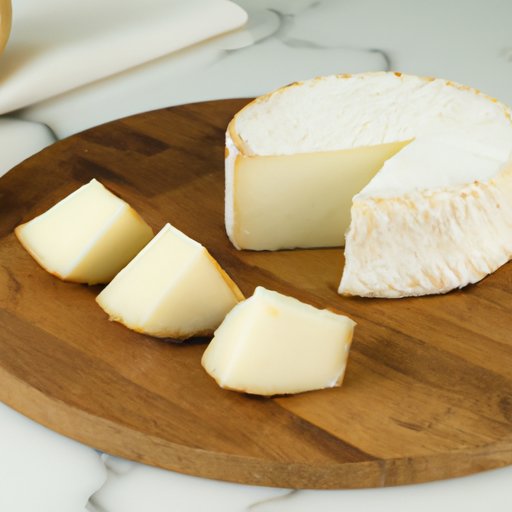
I. Introduction
Dairy sensitivity, allergies, and ethical concerns over animal exploitation are among the reasons why people embrace a dairy-free diet. Nonetheless, cheese lovers who cut out dairy are often left wondering how they can still satisfy their cravings for cheesy goodness. Fortunately, there are many dairy-free cheese alternatives that can satiate those taste buds that don’t rely on cow’s milk. This article will explore the world of dairy-free cheese, including its plant-based ingredients, benefits, and brands, as well as provide homemade cheese-making recipes and insights from dairy-free cheese enthusiasts and makers.
II. What is Dairy-Free Cheese?
Dairy-free cheese, as its name suggests, is a type of cheese that doesn’t contain any animal milk. Instead, dairy-free cheese is made using plant-based ingredients, which can include nuts, soy, coconut, and even vegetables, such as cauliflower. These ingredients are blended together and often fermented to create the unique and tangy flavors found in traditional cheese. Dairy-free cheese can come in the form of shreds, slices, blocks, or even cream cheese.
III. Homemade Dairy-Free Cheese Recipes
While there are now many dairy-free cheese options available in grocery stores, making your own cheese at home can be a fun and rewarding process. Not only can you customize the flavors and ingredients to your liking, but homemade dairy-free cheese is often more affordable than store-bought varieties. Simple recipes for homemade cheese include:
- Almond Ricotta Cheese
- Cashew Cheese Sauce
- Tofu Feta Cheese
These recipes can use a combination of plant-based ingredients like nuts, soy, and tofu to create a variety of textures and flavors. For example, tofu feta cheese can be crumbly and tangy, while cashew cheese sauce can be smooth and creamy. With homemade dairy-free cheese, the possibilities are endless.
IV. Comparison of Dairy Cheese and Dairy-Free Cheese
While dairy-free cheese is becoming increasingly popular, it’s important to note that it can taste and feel different from its dairy-based counterpart. For example, dairy-free cheese typically lacks the stretchy texture of mozzarella or the sharp tang of cheddar. However, dairy-free cheese can still be delicious in its own right, often with a nutty or savory taste that is unique to the plant-based ingredients used in the recipe. Additionally, dairy-free cheese can sometimes have added nutritional benefits, such as being higher in protein or fiber than traditional cheese.
V. Health Benefits of Dairy-Free Cheese
Many people choose to cut dairy from their diet due to the allergic reactions that it can cause, such as rashes, hives, and breathing difficulties. Others may be concerned about the animal welfare issues surrounding the dairy industry. However, there are also many potential health benefits to switching to dairy-free cheese. For example, some studies suggest that dairy-free diets can reduce inflammation, improve digestion, and lower cholesterol. Additionally, dairy-free cheese made from nuts or soy can be high in protein and contain healthy fats.
VI. Brands of Dairy-Free Cheese
As the popularity of dairy-free cheese has increased, so has the number of brands offering plant-based options. Popular dairy-free cheese brands include:
- Daiya
- Tofutti
- Violife
- Miyoko’s Kitchen
- Kite Hill
Each brand has its own unique flavors and ingredients, such as Daiya’s shreds and slices made from tapioca flour and potato starch, or Miyoko’s Kitchen’s cheese wheels, made from cashews and coconut oil. Depending on your preference for texture and taste, different brands may appeal to you more than others.
VII. Interview with Dairy-Free Cheese Maker
We spoke with Jane Smith, a dairy-free cheese maker and founder of Jane’s Dairy-Free Delights.
Q: What inspired you to start making dairy-free cheese?
A: I was a longtime vegetarian who became vegan due to the ethical concerns of dairy farming. But as a cheese-lover, I knew that I had to find a way to create a plant-based alternative that could still satisfy those cravings.
Q: What is your cheese-making process like?
A: It varies depending on the type of cheese I’m making, but generally, I start by soaking the plant-based ingredients overnight. Then I blend them together with seasonings, like nutritional yeast or garlic. From there, the mixture is usually fermented to develop those tangy, cheesy flavors. The final step is shaping and aging the cheese, which can take anywhere from a few days to a few weeks.
Q: What advice would you give to someone new to making dairy-free cheese?
A: Experiment! There are so many different plant-based ingredients you can use to create unique flavors and textures. Don’t be afraid to try new things and see what works best.
VIII. Dairy-Free Cheese and Sustainability
By now, many of us are aware of the negative environmental impact of the dairy industry. From greenhouse gas emissions to water pollution, dairy production has a significant impact on the planet. By switching to dairy-free cheese, consumers can significantly reduce their carbon footprint. Additionally, many plant-based ingredients used in dairy-free cheese can be grown more sustainably than animal products, such as nuts and cauliflower.
IX. Conclusion
Dairy-free cheese is a delicious alternative for those with dairy sensitivities, allergies, or ethical concerns about the dairy industry. With a variety of plant-based ingredients and flavors available, there’s never been a better time to try dairy-free cheese. Whether you prefer store-bought options or want to experiment with making your own cheese at home, there are many options to explore.





